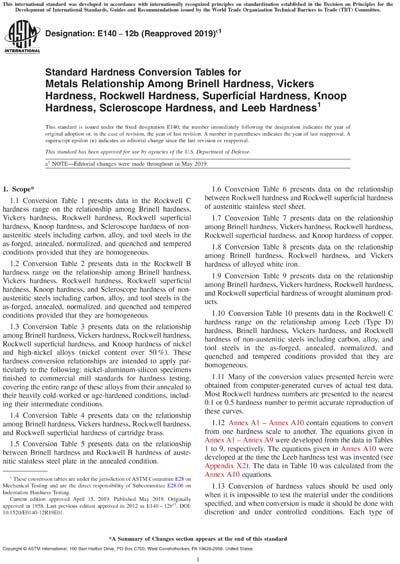Most recent
ASTM E140-12B(2019)e1
Standard Hardness Conversion Tables for Metals Relationship Among Brinell Hardness, Vickers Hardness, Rockwell Hardness, Superficial Hardness, Knoop Hardness, Scleroscope Hardness, and Leeb Hardness
1.1 Conversion Table 1 presents data in the Rockwell C hardness range on the relationship among Brinell hardness, Vickers hardness, Rockwell hardness, Rockwell superficial hardness, Knoop hardness, and Scleroscope hardness of non-austenitic steels including carbon, alloy, and tool steels in the as-forged, annealed, normalized, and quenched and tempered conditions provided that they are homogeneous.
1.2 Conversion Table 2 presents data in the Rockwell B hardness range on the relationship among Brinell hardness, Vickers hardness, Rockwell hardness, Rockwell superficial hardness, Knoop hardness, and Scleroscope hardness of non-austenitic steels including carbon, alloy, and tool steels in the as-forged, annealed, normalized, and quenched and tempered conditions provided that they are homogeneous.
1.3 Conversion Table 3 presents data on the relationship among Brinell hardness, Vickers hardness, Rockwell hardness, Rockwell superficial hardness, and Knoop hardness of nickel and high-nickel alloys (nickel content over 50 %). These hardness conversion relationships are intended to apply particularly to the following: nickel-aluminum-silicon specimens finished to commercial mill standards for hardness testing, covering the entire range of these alloys from their annealed to their heavily cold-worked or age-hardened conditions, including their intermediate conditions.
1.4 Conversion Table 4 presents data on the relationship among Brinell hardness, Vickers hardness, Rockwell hardness, and Rockwell superficial hardness of cartridge brass.
1.5 Conversion Table 5 presents data on the relationship between Brinell hardness and Rockwell B hardness of austenitic stainless steel plate in the annealed condition.
1.6 Conversion Table 6 presents data on the relationship between Rockwell hardness and Rockwell superficial hardness of austenitic stainless steel sheet.
1.7 Conversion Table 7 presents data on the relationship among Brinell hardness, Vickers hardness, Rockwell hardness, Rockwell superficial hardness, and Knoop hardness of copper.
1.8 Conversion Table 8 presents data on the relationship among Brinell hardness, Rockwell hardness, and Vickers hardness of alloyed white iron.
1.9 Conversion Table 9 presents data on the relationship among Brinell hardness, Vickers hardness, Rockwell hardness, and Rockwell superficial hardness of wrought aluminum products.
1.10 Conversion Table 10 presents data in the Rockwell C hardness range on the relationship among Leeb (Type D) hardness, Brinell hardness, Vickers hardness, and Rockwell hardness of non-austenitic steels including carbon, alloy, and tool steels in the as-forged, annealed, normalized, and quenched and tempered conditions provided that they are homogeneous.
1.11 Many of the conversion values presented herein were obtained from computer-generated curves of actual test data. Most Rockwell hardness numbers are presented to the nearest 0.1 or 0.5 hardness number to permit accurate reproduction of these curves.
1.12 Annex A1 – Annex A10 contain equations to convert from one hardness scale to another. The equations given in Annex A1 – Annex A9 were developed from the data in Tables 1 to 9, respectively. The equations given in Annex A10 were developed at the time the Leeb hardness test was invented (see Appendix X2). The data in Table 10 was calculated from the Annex A10 equations.
1.13 Conversion of hardness values should be used only when it is impossible to test the material under the conditions specified, and when conversion is made it should be done with discretion and under controlled conditions. Each type of hardness test is subject to certain errors, but if precautions are carefully observed, the reliability of hardness readings made on instruments of the indentation type will be found comparable. Differences in sensitivity within the range of a given hardness scale (for example, Rockwell B) may be greater than between two different scales or types of instruments. The conversion values, whether from the tables or calculated from the equations, are only approximate and may be inaccurate for specific application.
1.14 This international standard was developed in accordance with internationally recognized principles on standardization established in the Decision on Principles for the Development of International Standards, Guides and Recommendations issued by the World Trade Organization Technical Barriers to Trade (TBT) Committee.
Content Provider
ASTM International [astm]






